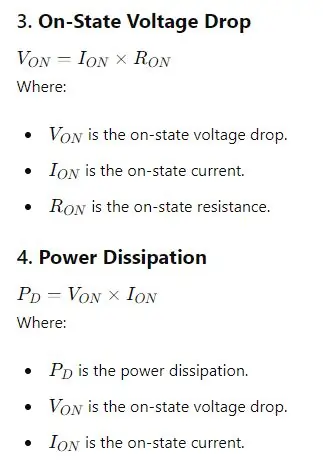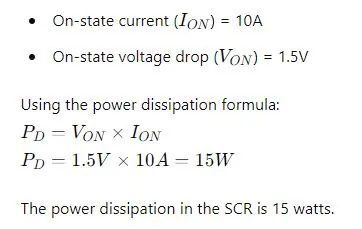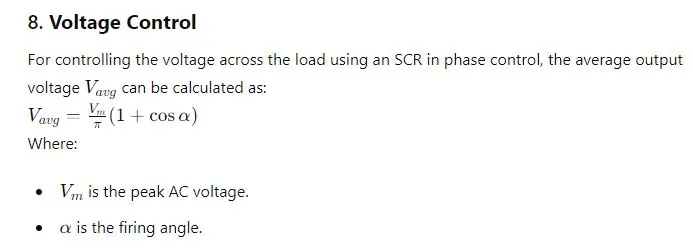Silicon Controlled Rectifier
Silicon Controlled Rectifiers (SCRs) are crucial components in modern electronics, significantly impacting power control and conversion in various devices and systems. From industrial machinery to consumer electronics, SCRs enable efficient and reliable operation across numerous applications.
In this blog post, we’ll explore the top 10 most powerful trends and tips for SCRs, providing valuable insights and practical advice to enhance your understanding and use of these essential components. You’ll discover the latest advancements in SCR technology, learn about emerging applications transforming industries, and gain best practices for optimizing performance and safety. Whether you’re an engineer, a hobbyist, or simply interested in the technology that drives our world, this guide will equip you with the knowledge needed to effectively leverage SCRs in your projects.
Understanding SCRs
Definition and Basic Operation
Brief Definition: A Silicon Controlled Rectifier (SCR) is a type of semiconductor device that acts as a switch, allowing electrical current to flow when it is triggered by a gate signal. It is a member of the thyristor family and is commonly used for controlling high power in electrical circuits.
How SCRs Function in Electronic Circuits: An SCR has three terminals: anode, cathode, and gate. The device remains in the off state (blocking current) until a small gate current is applied. When the gate receives a trigger pulse, the SCR turns on, allowing current to flow from the anode to the cathode. The SCR remains in the on state as long as the current through it exceeds the holding current. To turn off the SCR, the current must drop below this holding current level, or it must be forcibly commutated in AC circuits.
History and Development
Evolution of SCR Technology: The Silicon Controlled Rectifier was first developed in the late 1950s by a team of engineers at General Electric led by Gordon Hall and Frank W. “Bill” Gutzwiller. This invention was a significant advancement in power electronics, providing a more efficient and reliable means of controlling high power.
Key Milestones and Innovations:
- 1957: The first commercial SCR was introduced by General Electric.
- 1960s: Rapid adoption of SCRs in industrial applications for motor control, light dimming, and power conversion.
- 1970s: Advances in SCR manufacturing technology improved performance and reduced costs, making SCRs more accessible for consumer electronics.
- 1980s: Introduction of high-power SCRs capable of handling higher currents and voltages, expanding their use in utility and grid applications.
- 2000s: Integration of SCRs with modern digital control systems, enhancing their functionality in complex electronic circuits.
- 2010s and beyond: Continued innovation in SCR materials and design, leading to higher efficiency, improved thermal management, and expanded applications in renewable energy systems and electric vehicles.
Essential Formulae and Concepts for SCRs
1. Voltage and Current Ratings
- Breakover Voltage (V_BO): The voltage at which the SCR switches from the off state to the on state without gate current.
- Holding Current (I_H): The minimum current required to keep the SCR in the on state.
2. Gate Triggering
- Gate Trigger Voltage (V_GT): The minimum voltage required at the gate to turn on the SCR.
- Gate Trigger Current (I_GT): The minimum current required at the gate to turn on the SCR.

5. Turn-On Time (t_ON)
The time required for the SCR to switch from the off state to the on state after the gate trigger is applied.
6. Turn-Off Time (t_OFF)
The time required for the SCR to switch from the on state to the off state after the anode current drops below the holding current.
7. Commutation
For SCRs in AC circuits, the commutation process is essential for turning off the SCR at the zero-crossing point of the AC waveform.
Example Calculation
Let’s consider an example to calculate the power dissipation in an SCR.
Given:


Latest Trends in SCR Technology
Advancements in Manufacturing
Recent Improvements in SCR Production: Recent advancements in semiconductor manufacturing techniques have significantly enhanced the production of Silicon Controlled Rectifiers (SCRs). Innovations such as advanced doping methods, improved wafer fabrication processes, and the adoption of high-purity silicon have led to the development of SCRs with better performance characteristics. Additionally, the implementation of automated and precision-controlled manufacturing processes has resulted in more consistent and reliable SCR devices.
Impact on Performance and Cost: These manufacturing advancements have a direct impact on the performance and cost of SCRs. Modern SCRs exhibit lower on-state voltage drops, higher current carrying capacities, and improved thermal management. These improvements enhance the efficiency and reliability of SCRs, making them more suitable for demanding applications. Furthermore, the cost of production has been reduced due to the increased efficiency and automation of manufacturing processes, making SCRs more affordable for a wider range of applications.
Emerging Applications
Use in Renewable Energy Systems: One of the most notable emerging applications of SCRs is in renewable energy systems. SCRs play a crucial role in the control and conversion of power in solar and wind energy systems. They are used in inverter circuits to convert DC power generated by solar panels or wind turbines into AC power suitable for grid use. The ability of SCRs to handle high power levels and their robustness make them ideal for these renewable energy applications.
Integration in Electric Vehicles: SCRs are also increasingly being integrated into electric vehicles (EVs). They are used in the power management systems of EVs to control the flow of electricity between the battery, motor, and other electronic components. SCRs help in managing the charging and discharging processes of the battery, ensuring efficient power utilization and enhancing the overall performance of the vehicle. The reliability and efficiency of modern SCRs are critical for the development of advanced and efficient electric vehicles.
Modern Electronic Systems
Role of SCRs in Contemporary Electronic Devices: In contemporary electronic devices, SCRs continue to play a significant role. They are used in various power control applications, such as in power supplies, motor controllers, and light dimmers. The ability of SCRs to precisely control large amounts of power makes them indispensable in these applications.
Examples of Innovative Applications:
- Smart Grids: SCRs are used in smart grid systems to regulate power flow, ensuring stability and efficiency in power distribution networks.
- Industrial Automation: In industrial settings, SCRs are used to control heavy machinery and equipment, providing precise control over motor speeds and other critical functions.
- Consumer Electronics: In consumer electronics, SCRs are used in devices such as washing machines, refrigerators, and HVAC systems to control various operational parameters, improving energy efficiency and performance.
Practical Tips for Using SCRs
Design and Simulation
Recommended Software Tools: For designing and simulating circuits involving Silicon Controlled Rectifiers (SCRs), several software tools can be highly beneficial. Some of the most popular and effective tools include:
- SPICE (Simulation Program with Integrated Circuit Emphasis): Widely used for simulating electronic circuits, providing detailed analysis of SCR behavior in various circuit configurations.
- LTspice: A free, high-performance SPICE simulator offered by Analog Devices, ideal for designing and testing SCR circuits.
- PSIM: A power electronics simulation tool that offers robust capabilities for simulating power conversion systems involving SCRs.
- PSpice: Another popular circuit simulation tool that offers comprehensive modeling and analysis features for SCR-based circuits.
Tips for Effective Circuit Design and Simulation:
- Accurate Modeling: Ensure accurate modeling of the SCR and other components in your circuit. Use manufacturer-provided models or validated third-party models for simulation.
- Thermal Considerations: Include thermal management in your design. Simulate the thermal behavior of the SCR under different operating conditions to prevent overheating.
- Gate Drive Circuits: Design robust gate drive circuits to ensure reliable triggering of the SCR. Use appropriate gate resistors and consider the gate current requirements.
- Transient Analysis: Perform transient analysis to study the SCR’s behavior during switching events, which can help identify potential issues such as voltage spikes and oscillations.
- Iteration and Testing: Iterate your design based on simulation results and perform extensive testing under various conditions to validate the performance and reliability of your SCR circuit.
Safety and Handling
Guidelines for Safe Operation:
- Proper Ratings: Always ensure that the SCR is operated within its specified voltage and current ratings to avoid damage.
- Heat Sinks: Use adequate heat sinks or cooling mechanisms to dissipate heat generated during operation.
- Protection Circuits: Implement protection circuits such as snubber circuits to protect the SCR from voltage spikes and transients.
- Isolation: Ensure proper isolation between the gate and the main power circuit to prevent accidental triggering.
Common Failure Modes and Troubleshooting Tips:
- Overheating: Overheating can lead to SCR failure. Ensure proper cooling and check for any thermal issues in your design.
- Gate Misfires: Gate misfires can cause erratic behavior. Check the gate drive circuit for proper triggering signals and ensure the gate current is sufficient.
- Latch-Up: Latch-up occurs when the SCR remains on even after the gate signal is removed. This can be caused by excessive current. Ensure the current is within the specified limits.
- Short Circuits: Short circuits can damage the SCR. Use fuses or circuit breakers to protect against short circuit conditions.
Efficiency and Performance Optimization
How to Maximize SCR Efficiency:
- Minimize On-State Voltage Drop: Choose SCRs with low on-state voltage drop to reduce power losses.
- Proper Heat Management: Use effective heat sinks and thermal management techniques to keep the SCR within its optimal temperature range.
- Efficient Gate Drive: Optimize the gate drive circuit to ensure fast and reliable triggering with minimal power consumption.
Best Practices for Enhancing Performance:
- Regular Maintenance: Perform regular maintenance checks on the SCR and associated circuitry to ensure optimal performance.
- Use High-Quality Components: Use high-quality, reliable components in your design to enhance the overall performance and longevity of the SCR.
- Circuit Layout: Optimize the circuit layout to minimize parasitic inductance and capacitance, which can affect the performance of the SCR.
- Environmental Considerations: Consider the operating environment and ensure the SCR is protected from moisture, dust, and other contaminants that could impact performance.
Comparative Insights
| Aspect | SCR (Silicon Controlled Rectifier) | Diodes | Transistors | Thyristors |
|---|---|---|---|---|
| Basic Function | Acts as a switch; allows current flow when triggered | Allows current to flow in one direction | Acts as a switch or amplifier | Acts as a switch; similar to SCR but with more layers |
| Control Mechanism | Triggered by gate signal | No control mechanism | Controlled by base current/voltage | Triggered by gate signal, but requires more complex triggering |
| On-State Voltage Drop | Typically higher (1-2V) | Lower (0.7V for silicon diodes) | Lower (0.2-0.3V for silicon transistors) | Higher than diodes and transistors, similar to SCR |
| Switching Speed | Moderate | Fast | Very fast | Moderate to slow, depending on the type |
| Power Handling Capability | High | Low to medium | Low to medium | High |
| Applications | Power control, AC/DC conversion, motor control | Rectification, signal demodulation | Amplification, switching, signal processing | Power control, AC/DC conversion, light dimming |
| Advantages | High power capability, robustness | Simple, low cost | Fast switching, amplification | High power capability, robustness |
| Disadvantages | Higher voltage drop, slower than transistors | Limited to unidirectional current flow | Lower power handling compared to SCRs | More complex triggering, slower than transistors |
| Use-Cases | Industrial motor control, power grids, inverters | Power supplies, signal rectifiers | Logic circuits, amplifiers, digital circuits | Similar to SCRs, used in high-power AC applications |
| Selection Criteria | High power applications, need for controlled switching | Simple rectification needs | Fast switching needs, signal processing | High power applications, complex triggering requirements |
Specific Use-Cases for Each Device
| Device | Specific Use-Cases |
|---|---|
| SCR | – Industrial motor control |
| – AC/DC power conversion | |
| – Light dimmers | |
| – Inverters in renewable energy systems | |
| Diodes | – Power supply rectifiers |
| – Signal demodulation in communication systems | |
| – Voltage clamping and protection circuits | |
| – Light Emitting Diodes (LEDs) | |
| Transistors | – Amplifiers in audio and radio frequency circuits |
| – Switching in digital logic circuits | |
| – Signal processing in analog circuits | |
| – Voltage regulation in power supplies | |
| Thyristors | – High-power AC applications |
| – Light dimming and heating control | |
| – Phase control in AC power systems | |
| – Crowbar circuits for overvoltage protection |
Selection Criteria for Engineers and Designers
- Power Handling: Choose SCRs or thyristors for high-power applications; diodes or transistors for low to medium power needs.
- Switching Speed: Opt for transistors for high-speed switching; SCRs and thyristors are better for applications where speed is less critical.
- Control Requirements: Use SCRs and thyristors for applications requiring controlled switching; diodes for simple rectification; transistors for applications needing amplification and fast switching.
- Cost and Complexity: Diodes are cost-effective and simple to use; transistors offer a balance of speed and control; SCRs and thyristors are suitable for more complex and high-power applications.
Market Trends and Future Outlook
Market Analysis
Current Market Demand and Supply Trends: The market for Silicon Controlled Rectifiers (SCRs) is experiencing significant growth due to increasing demand for efficient power control solutions across various industries. The rising adoption of renewable energy systems, electric vehicles, and industrial automation is driving the demand for high-performance SCRs. Additionally, the growing focus on energy efficiency and power management in consumer electronics is contributing to the increased use of SCRs.
On the supply side, advancements in semiconductor manufacturing technologies are enabling the production of more efficient and cost-effective SCRs. This has led to a steady supply of high-quality SCRs in the market, meeting the growing demand. The competition among manufacturers is driving innovation and the development of new products with enhanced performance characteristics.
Key Manufacturers and Their Latest Products
Infineon Technologies: Infineon is a leading player in the SCR market, offering a wide range of SCRs for various applications. Their latest products include high-voltage SCRs designed for use in industrial and automotive applications. These SCRs feature improved thermal performance and higher current carrying capabilities.
ON Semiconductor: ON Semiconductor provides SCRs that are widely used in power conversion and control applications. Their recent offerings include SCRs with enhanced gate sensitivity and lower on-state voltage drop, making them ideal for efficient power management in consumer electronics and industrial systems.
STMicroelectronics: STMicroelectronics is known for its high-reliability SCRs used in both industrial and consumer applications. Their latest products include SCRs with integrated protection features, such as over-voltage and over-current protection, ensuring safe and reliable operation in critical applications.
Littelfuse: Littelfuse offers a comprehensive range of SCRs designed for robust performance in harsh environments. Their newest SCRs are optimized for use in renewable energy systems and electric vehicles, featuring high surge capability and excellent thermal stability.
Forecasting the Future of SCR Technology
The future of SCR technology looks promising, with several trends shaping its development and adoption:
Increasing Integration in Renewable Energy Systems: As the world shifts towards sustainable energy sources, SCRs will play a crucial role in power conversion and control within solar and wind energy systems. The demand for SCRs in these applications is expected to grow significantly, driven by the need for efficient and reliable power management solutions.
Advancements in Electric Vehicles: The electric vehicle market is set to expand rapidly in the coming years, and SCRs will be essential components in EV power management systems. Innovations in SCR technology will focus on improving efficiency, reducing size, and enhancing thermal management to meet the stringent requirements of electric vehicles.
Smart Grid and Industrial Automation: SCRs will continue to be vital in smart grid applications, where they are used to regulate and control power flow, ensuring grid stability and efficiency. In industrial automation, the trend towards more sophisticated and efficient control systems will drive the demand for advanced SCRs with better performance and reliability.
Miniaturization and Integration: The trend towards miniaturization and integration of electronic components will influence SCR technology. Future SCRs will be designed to be smaller, more efficient, and integrated with other components to provide comprehensive power management solutions in compact form factors.
Emerging Markets and Applications: New markets and applications for SCRs are emerging, including their use in advanced medical devices, aerospace, and telecommunications. These applications will require SCRs with specialized features, such as high reliability, low power consumption, and precise control capabilities.
FAQ on Silicon Controlled Rectifiers (SCR)
Q: What is a Silicon Controlled Rectifier (SCR)?
A: An SCR is a semiconductor switch controlled by a gate signal.
Q: How does an SCR function in a circuit?
A: It allows current flow when a gate current is applied.
Q: What are the common applications of SCRs?
A: Power control, AC/DC conversion, motor control, and light dimming.
Q: How can the efficiency of an SCR be optimized?
A: Minimize on-state voltage drop, manage heat, and use an efficient gate drive.
Conclusion
Silicon Controlled Rectifiers (SCRs) are essential components in modern electronics, offering reliable and efficient power control solutions across a wide range of applications. From industrial machinery to renewable energy systems and electric vehicles, SCRs play a critical role in ensuring optimal performance and efficiency. By understanding the latest trends, advancements, and practical tips for using SCRs, engineers and designers can make informed decisions to enhance their projects. As technology continues to evolve, SCRs will remain at the forefront of power management solutions, driving innovation and efficiency in various industries. Stay informed and leverage these insights to maximize the potential of SCR technology in your applications.